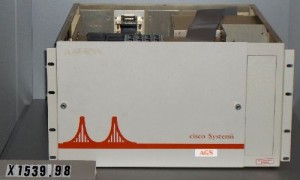Birth of the Commercial Internet
Once upon a time, way back in 1991, the entire commercial Internet consisted of a single Cisco AGS router located in Tyson’s Corner, Virginia. At the time that the so-called Commercial Internet Exchange (CIX) was established, most Internet users connected to each other over the NSFNET backbone, a network bound by an Acceptable Use Policy that prohibited commercial uses except for e-mail. Commercial users of IP connected to commercial operators such as PSI, UUnet, and CERFNet, and these operators connected to each other over the ANS network that was the commercial arm of an academic consortium in the Midwest and proud owner of a sweetheart monopoly deal with the National Science Foundation. The three operators wanted to exchange traffic with each directly without paying fees to ANS, so they formed the CIX and connected 1.44 Mb/s T1 lines to the AGS.
 Shortly after it was launched, they moved the CIX to Santa Clara, CA, where it served as the model for the modern Internet Exchange Points (IXPs) that dot the country in the NFL cities today. According to legend, the original AGS is now located at the Equinix office in Reston, VA, and its replacement, a Cisco 7500, is in the Smithsonian.
Shortly after it was launched, they moved the CIX to Santa Clara, CA, where it served as the model for the modern Internet Exchange Points (IXPs) that dot the country in the NFL cities today. According to legend, the original AGS is now located at the Equinix office in Reston, VA, and its replacement, a Cisco 7500, is in the Smithsonian.
It’s unusual that the CIX was built on a router, as the modern IXPs interconnect through Ethernet switches, typically of the 10 Gb/s variety. There aren’t as many IXPs as you might think, by some estimates they number in the low hundreds worldwide. A milestone for any developing country is the founding of its first internal IXP, as many countries don’t have one at all. Pakistan, for example, connects to the Internet in Hong Kong, which makes Internet use there vulnerable in several different ways.



